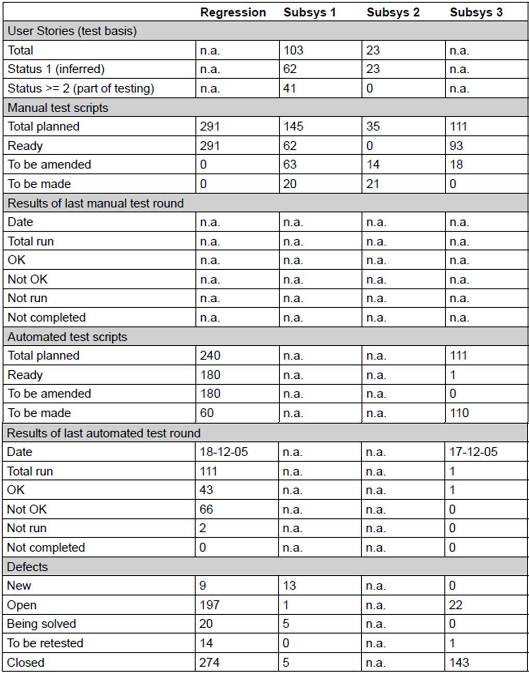Test process management is aimed at administering the test process in terms of progress and quality, and providing
insight into the quality of the test object. To this end, identification, registration, administration, storage and
interpretation of the following details has to take place:
-
Progress and the expenditure of budget and time
-
Quality indicators
-
Test statistics
This management is sometimes assigned to a dedicated role: test project administrator (see Roles Not Described As A Position).
This information forms the basis for managing and reporting by test management. Since control over the test process is
increasing in importance, management is under pressure regarding the test process. Fast – preferably real-time –
insight is required into the actual status quo. In this connection, the term dashboard is used: a simple overview from
which all the superfluous information is removed and that provides the most important information at a glance: the
quality of the test object (in terms of defects) and the progress of the test process. Planning and progress monitoring
tools but also testware management tools can be an excellent support here.
Below is an example:

(n.a. = not applicable)
Progress and expenditure of budget and time
The progress information offers the client and the test management insight into the test process. On the basis of this,
the test process can be redirected, if necessary. Where there are negative trends, timely measures can be adopted. The
parts to be managed are the activities and/or products, related to hours, resources, timeline and with mutual
dependencies.
Quality indicators
The aim of testing is to provide information and advice on the risks and quality of the object to be tested.
To be able to provide this information, quality indicators are registered. The best-known and most obvious indicator is
the defect. By establishing all kinds of details on a defect, such as e.g. status, severity, cause, quality
characteristic and system part, all kinds of qualitative information can be gleaned from the defects at a later stage.
Bear in mind the number of open defects relating to a particular part of the system, the number of defects found in a
particular period, the number of defects relating to the requirements, etc. For more information on defects, refer
to Defects Management. Various other indicators are also possible. For example, the
number of retests or the number of breakdowns within the test infrastructure (as an indicator of its reliability). The
above-mentioned indicators tell us something about the quality of the test object. Another group of indicators tells us
something about the quality of the test process itself. For example (see Report (AST)):
|
Effectiveness of testing
|
Are the (important) defects being found?
|
|
Efficiency of testing
|
Are the defects being found as quickly and cheaply as possible?
|
|
Checkability of testing
|
Is the test process progressing transparently and in the agreed way?
|
Test statistics
The test manager builds statistics based on the above information. Statistics can supply insight into the progress of
the test process and quality of the test object, including any trends. And statistics can also apply to the quality of
the test process itself.
|
